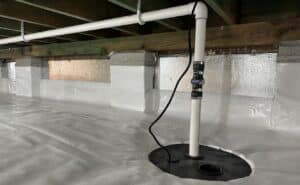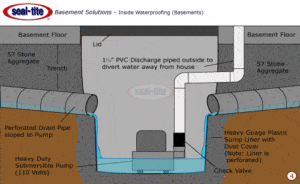Flooded basements can be a homeowner’s nightmare, but sump pumps offer a safeguard. This guide explains their operation, explores types, and offers advice on selection and maintenance, equipping you with the knowledge to avert water damage and safeguard your home.
Key Takeaways
- Sump pumps, installed in a sump basin, automatically pump out excess water from basements or crawl spaces to prevent flooding and structural damage.
- There are two main types of sump pumps for homeowners: submersible pumps, which are quiet and space-saving, and pedestal pumps, which are cost-effective and easily maintained.
- Regular maintenance, correct installation with a GFCI outlet, proper drainage, and being attuned to signs of failure are essential to ensure the long-term effectiveness and reliability of sump pumps.
Understanding Sump Pumps: A Primer
A sump pump is an essential device that helps protect homes from water damage by keeping basements and crawl spaces dry. It works by removing excess water, which tends to accumulate in a designated area called the sump basin located in lower parts of basements or crawl spaces.
The mechanism behind how a sump pump operates is quite straightforward, it has sensors that detect rising levels or pressure of water. Once the water reaches a certain level, the pump automatically starts working and pumps out the excess through a discharge line connected to your home’s exterior. By doing this, it prevents potential structural harm and health hazards caused by moisture-induced mold growth.
Having a reliable sump pump installed can effectively prevent basement flooding as well as safeguard against any resulting damages.
The Mechanics Behind Sump Pumps
An in-depth examination of the inner workings of a sump pump reveals a well-coordinated system designed to protect your home from flooding and water damage. The valves, considered to be the core components of this device, are responsible for detecting changes in water level or pressure and triggering the pump accordingly.
Once activated, the sump pump uses its centrifugal mechanism along with an impeller to create enough force that propels water out through a discharge pipe. It is crucially important to ensure proper installation and configuration of this line so that expelled water does not find its way back into your home by extending it far away from your foundation.
Ultimately, the efficiency of the sump pump largely relies on how precisely you install the discharge line to prevent any potential harm caused by rising water levels within your property’s perimeter. As soon as these pipes are strategically installed, the equipment will smoothly suck up excess floodwaters and relocate them outside safely through an elaborate drainage system thus ensuring a dry, and secure interior environment for homeowners. By taking into consideration these essential factors, you can assure that your experience is both effective and often, lifesaving in preventing potential disasters before they even happen.
Essential Types of Sump Pumps for Homeowners
Carefully choosing a suitable sump pump is essential in protecting your home from potential water damage. There are two main types of sump pumps commonly utilized in residential settings: submersible and pedestal pumps, each with their unique features and benefits.
Submersible Sump Pump Advantages
Submersible sump pumps are designed to be fully immersed in water, making them a popular choice for homeowners who desire quiet operation and an organized basement. These pumps are installed directly into the sump pit which is filled with water. Their submerged function ensures they run silently, making them preferred among residential settings where noise reduction is crucial.
The compact design of submersible pumps allows for easy installation within the sump basin while occupying less space in your basement or crawl space. This feature proves advantageous for houses with limited basements or smaller sump pits.
Pedestal Pumps: When to Choose Them
When considering different pump options, it’s important to note the benefits of pedestal pumps. Unlike submersible pumps that are placed inside the sump pit, pedestal pumps are mounted above it, which makes them more visible and easier to maintain. This type of design also offers cost-saving advantages for homeowners on a budget as they tend to have lower price points ranging from $75-$200 with installation costs potentially reaching up to $800.
One major advantage of choosing a pedestal pump is its convenient location above the sump pit. Not only does this allow for better access during maintenance tasks, but it can also save money in the long run through simpler upkeep procedures. These types of pumps offer an affordable alternative compared to other varieties such as submersibles.
Overall, many homeowners find pedestal pumps appealing due to their advantageous features and potential savings opportunities over time thanks primarily to their positioning away from water sources within existing structures like basements or crawlspaces.
Backup Systems: Ensuring Continuous Operation
It is important to not only have a reliable primary sump pump but also consider having a backup system. Backup pumps are essential in ensuring protection against water damage when the primary pump fails or during power outages.
One popular type of backup system is the battery-powered sump pump, which includes a battery, charger, supplemental pump, and extra piping. This backup system automatically activates when there is an issue with the primary pump or during electricity blackouts.
There are other options for backups such as water-powered systems that do not rely on electricity and combination systems that offer both a main and battery-operated secondary option. These alternatives provide additional layers of safety to ensure continuous operation even if there is an issue with the main system. Regular testing must be conducted to guarantee their reliability by filling up the sump pit and checking if the backup kicks in once unplugged from its source.
To maintain efficient home protection against potential water damages caused by issues with your principal pumping mechanism failing or due to loss of electrical supply, it’s recommended you have dependable alternative solutions like auxiliary tools available at all times throughout the year. Predominantly used among these alternative methods include running standardized electric equipment that requires heavy-duty rechargeable batteries specifically designed for this purpose, and employing accessories containing lines, tubes, batteries, and radios. Have functioning devices permitting safeguard mechanisms able to be prepared either way in case machine default happens.
Installation Insights: Where and How to Set Up Your Sump Pump
After selecting the appropriate sump pump and backup system, installation must be considered. The ideal location for a sump pump is in a sump pit positioned at the lowest point of either a basement or crawl space where water naturally accumulates. If the existing pit is too small or shallow, it may require an above-ground pedestal pump instead of a submersible.
Aside from determining placement, proper installation is crucial to ensure the efficient functionality of the sump pump. It should be connected to household electricity and have access to Ground Fault Circuit Interrupter (GFCI) outlets as safety precautions against accidental electrocution. Verifying that the unit stands upright within its designated area will help prevent any potential malfunctions or disruptions during operation.
Preventative Maintenance for Longevity
A well-maintained sump pump not only performs better but also lasts longer. Here are some tips for maintaining your sump pump.
- Regularly inspect and clean the sump pit, removing any debris.
- Clean the inlet screen of the pump with a scrub brush.
- Periodically test the sump pump by pouring water into the pit and listening for any unusual noises during operation.
Following these maintenance tips can help ensure that your sump pump works correctly and identify potential issues.
In addition to these maintenance practices, the use of a Ground Fault Circuit Interrupter (GFCI) for the electrical outlet and a one-way check valve on the discharge line can increase the safety and longevity of the sump pump. While the lifespan of a sump pump can vary based on factors such as electrical source quality and frequency of use, regular maintenance can extend its lifespan significantly.
Recognizing Signs of Sump Pump Failure
Recognizing the indications of a sump pump failure early on can help you avoid a potential disaster. Some red flags to be aware of include noisy operation with whirring or clunking sounds, operational issues like excessive vibration and frequent cycling, and visible rust or noise from pedestal pumps that are more susceptible to overheating due to motor distress.
Problems such as blockages caused by debris in the sump system may lead to pump damage over time. This could result in increased strain on the impeller and ultimately cause failure. If your current sump pump has been functioning for 7-10 years, it might be wise to consider a replacement before any major failures occur.
To prevent unexpected breakdowns and malfunctions during critical times when water levels rise dramatically around properties at risk of flooding, it is important not only to pay attention to the signs revealed above but also to consider proactively replacing older models which have already aged out – especially because motors located on pedestals tend to become problematic faster than other types of Sumps within systems that aren’t maintained correctly through clogs resulting from accumulations of debris over time. The chances increase higher odds running against having your entire system fail all at once creating chaos once cleaning up residual property damages there reasons although frequently needing serious concern homeowners often forget this regularity habit performance even general maintenance. Accepting the fact well-made products are wisely contemplative instead of making unavoidable choices and treating ourselves at moment’s notice.
Selecting the Right Sump Pump for Your Needs
When faced with the task of choosing a suitable sump pump, it can seem daunting. Understanding key factors will make the selection process easier. The first thing to consider is horsepower – an important aspect in ensuring effective performance. Here are some pointers:
- Insufficient power could result in flooding.
- Excessive power may cause frequent cycling and reduce the lifespan of your pump.
- If your sump pump runs for extended periods, it might be struggling due to inadequate horsepower for handling water volume or distance, potentially leading to malfunction.
Another vital factor is the type of switch used for detecting water levels and controlling operation. One option is a vertical float switch which works well in small basins as its design prevents debris from getting stuck on it. Another alternative, is tethered float switches allow more flexibility when adjusting the pumping range.
For optimal performance in new installations, it is recommended to select pumps with a minimum power of 1/3 horsepower. However, residences located in areas with high groundwater levels or possessing deep basements necessitate more robust models, typically within the range of ½–¾ horsepower. These pumps are designed to efficiently handle the removal of excess water without encountering issues such as capacity failure under heightened pressure during heavy rainfall.
It is crucial to address these potential concerns preemptively by thoroughly considering various factors before investing in such equipment. This involves a comprehensive evaluation, including but not limited to accurate predictions of basement humidity patterns, analysis of past trends, consideration of seasonal changes, awareness of local peculiarities, and assessment of off-site work involvement. Technical capabilities, knowledge of special machinery, degree demands under specific conditions, and other relevant matters must also be taken into account.
Balancing these considerations ensures not only the effective operation of the pump but also prevents issues that may arise over time if not addressed promptly. Thoughtful consideration encompasses factors such as operational costs, family safety, overall functionality, and the features that cater to long-term planning, convenience, individual needs, and pricing.
Cost Considerations for Sump Pump Investment
The cost of investing in a sump pump goes beyond just the price of the pump itself. On average, a sump pump costs around $250, though this can vary depending on the specific model chosen. Adding professional installation to that can increase the overall cost by an additional $100-$200. If creating and setting up a sump pit is required, expect to pay anywhere from $750-$1,000.
When considering which type of material your sump pump should be made out of, keep in mind that while plastic options are typically less expensive initially, they may not hold up as well over time compared to cast iron pumps known for their durability and heat dissipation abilities. A combination of stainless steel and cast iron options also proves beneficial long term.
Mitigating Water Damage Risks with Proper Drainage
Properly functioning sump pumps are essential for keeping crawl spaces and basements dry. Effective drainage is also crucial to fully address the issue of excess water. To prevent potential flooding from occurring, the discharge from a sump pump must lead to a designated area far away from the home’s foundation.
A thorough inspection of outside discharge pipes should be conducted regularly to ensure they are unclogged and directing water at least 20 feet away from the house. Investing in quality gutter and downspout materials can provide better protection against heavy rains without needing frequent replacements due to weather damage.
In conclusion, a sump pump plays an instrumental role in protecting your home from water damage. Whether you opt for a submersible or pedestal pump, ensuring it has adequate horsepower, a reliable backup system, and proper drainage is crucial. Regular inspection, maintenance, and knowing the signs of failure can also go a long way in keeping your home safe and dry. So don’t overlook this silent hero in your basement. Protect your home, protect your peace of mind.
Contact the Professionals at Seal-Tite Basement Waterproofing Today! (703) 665-5589

Seal-tite Basement Waterproofing Co. is a full service basement environment contractor. We carry an A+ Better Business Bureau rating. We repaired over 40,000 homes and structures in Virginia, West Virginia, Tennessee, and North Carolina. We are fully insured and licensed. We have worked in all types of locations, including residential and commercial locations, government agencies, colleges, hospitals, churches, and condo associations.
Seal-tite® offers a lifetime transferable warranty. We carry a Class A Contractor’s License and we are fully insured. Our satisfied customers range from government agencies to businesses, hospitals, colleges, churches, and thousands of homeowners. Your home is probably the single largest investment you will make in your lifetime. Don’t wait, call Seal-tite® to help make your home dry, safe and livable.


 Call or email for a free estimate. For immediate help call
Call or email for a free estimate. For immediate help call  Start with trust. We’re BBB A+ Rated The Top Satisfaction Rate Awarded.
Start with trust. We’re BBB A+ Rated The Top Satisfaction Rate Awarded.